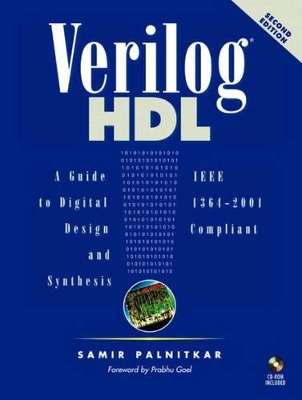
Verilog HDL
Prentice Hall
978-0-13-044911-5 (ISBN)
- Titel ist leider vergriffen;
keine Neuauflage - Artikel merken
Verilog HDL is a language for digital design, just as C is a language for programming. This complete Verilog HDL reference progresses from the basic Verilog concepts to the most advanced concepts in digital design. Palnitkar covers the gamut of Verilog HDL fundamentals, such as gate, RTL, and behavioral modeling, all the way to advanced concepts, such as timing simulation, switch level modeling, PLI, and logic synthesis. Verilog HDL is a hardware description language (with a user community of more than 50,000 active designers) used to design and document electronic systems. This completely updated reference progresses from basic to advanced concepts in digital design, including timing simulation, switch level modeling, PLI, and logic synthesis.
About the Author Samir Palnitkar is a recognized authority on Verilog HDL, modeling, verification, logic synthesis, and EDA-based methodologies in digital design. He has worked extensively with design and verification on various successful microprocessor, ASIC, and system projects. He was the lead developer of the Verilog framework for the shared memory, cache coherent, multiprocessor architecture, popularly known as the UltraSPARCTM Port Architecture, defined for Sun's next generation UltraSPARC-based desktop systems. Besides the UltraSPARC CPU, he has worked on a number of diverse design and verification projects at leading companies including Cisco, Philips, Mitsubishi, Motorola, National, Advanced Micro Devices, and Standard Microsystems.
(NOTE: Each chapter concludes with a Summary and Exercises.)
About the Author.
Foreword.
Preface.
Acknowledgments.
I. BASIC VERILOG TOPICS.
1. Overview of Digital Design with Verilog HDL.
Evolution of Computer-Aided Digital Design. Emergence of HDLs. Typical Design Flow. Importance of HDLs. Popularity of Verilog HDL. Trends in HDLs.
2. Hierarchical Modeling Concepts.
Design Methodologies. 4-bit Ripple Carry Counter. Modules. Instances. Components of a Simulation. Example.
3. Basic Concepts.
Lexical Conventions. Data Types. System Tasks and Compiler Directives.
4. Modules and Ports.
Modules. Ports. Hierarchical Names.
5. Gate-Level Modeling.
Gate Types. Gate Delays.
6. Dataflow Modeling.
Continuous Assignments. Delays. Expressions, Operators, and Operands. Operator Types. Examples.
7. Behavioral Modeling.
Structured Procedures. Procedural Assignments. Timing Controls. Conditional Statements. Multiway Branching. Loops. Sequential and Parallel Blocks. Generate Blocks. Examples.
8. Tasks and Functions.
Difference between Tasks and Functions. Tasks. Functions.
9. Useful Modeling Techniques.
Procedural Continuous Assignments. Overriding Parameters. Conditional Compilation and Execution. Time Scales. Useful System Tasks.
II. ADVANCED VERILOG TOPICS.
10. Timing and Delays.
Types of Delay Models. Path Delay Modeling. Timing Checks. Delay Back-Annotation.
11. Switch Level Modeling.
Switching-Modeling Elements. Examples.
12. User-Defined Primitives.
UDP basics. Combinational UDPs. Sequential UDPs. UDP Table Shorthand Symbols. Guidelines for UDP Design.
13. Programming Language Interface.
Uses of PLI. Linking and Invocation of PLI Tasks. Internal Data Representation. PLI Library Routines.
14. Logic Synthesis with Verilog HDL.
What Is Logic Synthesis? Impact of Logic Synthesis. Verilog HDL Synthesis. Synthesis Design Flow. Verification of the Gate-Level Netlist. Modeling Tips for Logic Synthesis. Example of Sequential Circuit Synthesis.
15. Advanced Verification Techniques.
Traditional Verification Flow. Assertion Checking. Formal Verification.
III. APPENDICES.
Appendix A. Strength Modeling and Advanced Net Definitions.
Strength Levels. Signal Contention. Advanced Net Types.
Appendix B. List of PLI Routines.
Conventions. Access Routines. Utility (tf_) Routines.
Appendix C. List of Keywords, System Tasks and Compiler Directives.
Keywords. System Tasks and Functions. Compiler Directives.
Appendix D. Formal Syntax Definition.
Source Text. Declarations. Primitive Instances. Module and Generated Instantiation. UDP Declaration and Instantiation. Behavioral Statements. Specify Section. Expressions. General.
Appendix E. Verilog Tidbits.
Appendix F. Verilog Examples.
Synthesizable FIFO Model. Behavioral DRAW Model.
Bibliography.
Index.
| Erscheint lt. Verlag | 5.3.2003 |
|---|---|
| Verlagsort | Upper Saddle River |
| Sprache | englisch |
| Maße | 242 x 181 mm |
| Gewicht | 916 g |
| Themenwelt | Mathematik / Informatik ► Informatik ► Netzwerke |
| Mathematik / Informatik ► Informatik ► Programmiersprachen / -werkzeuge | |
| Mathematik / Informatik ► Informatik ► Theorie / Studium | |
| Technik ► Elektrotechnik / Energietechnik | |
| ISBN-10 | 0-13-044911-3 / 0130449113 |
| ISBN-13 | 978-0-13-044911-5 / 9780130449115 |
| Zustand | Neuware |
| Haben Sie eine Frage zum Produkt? |